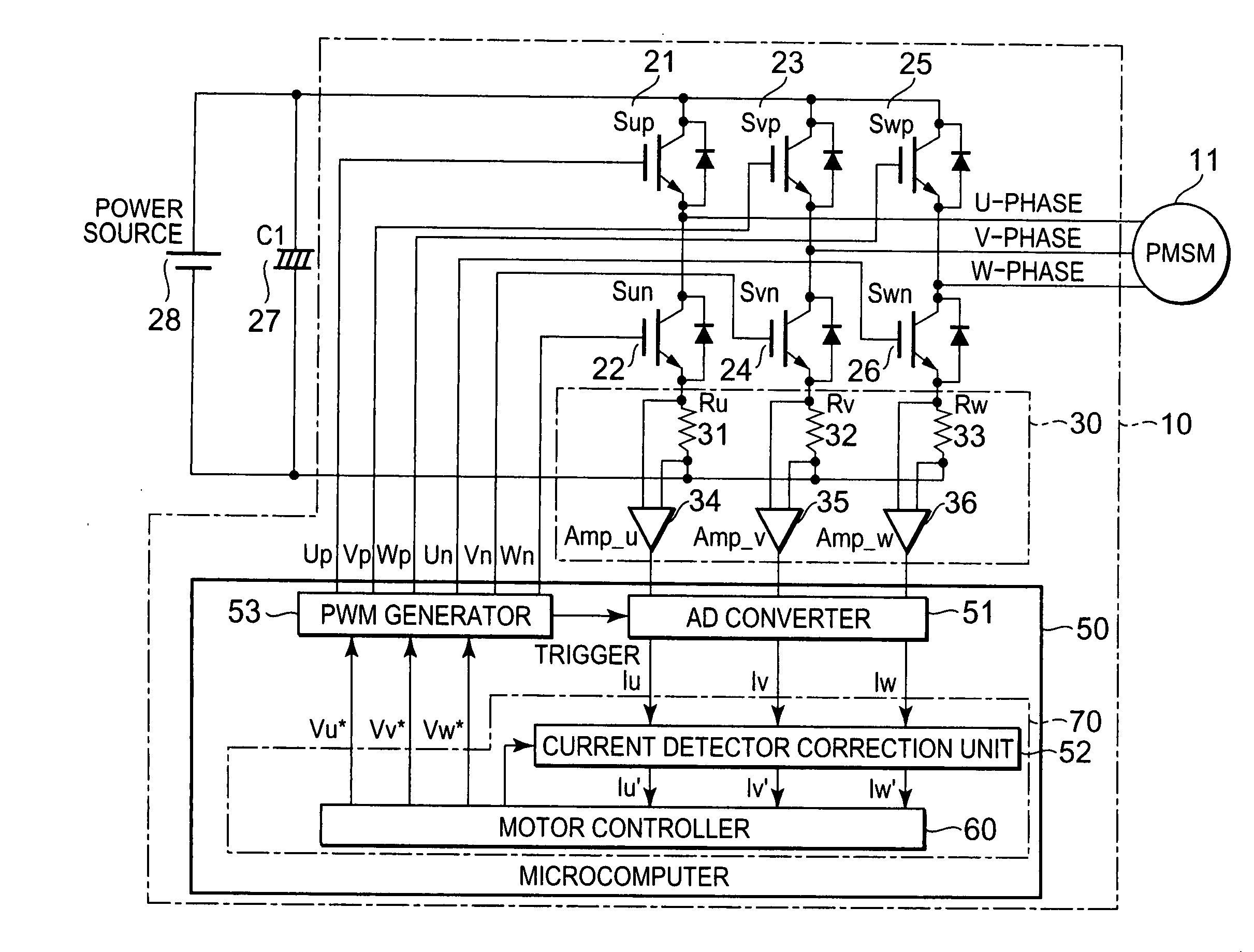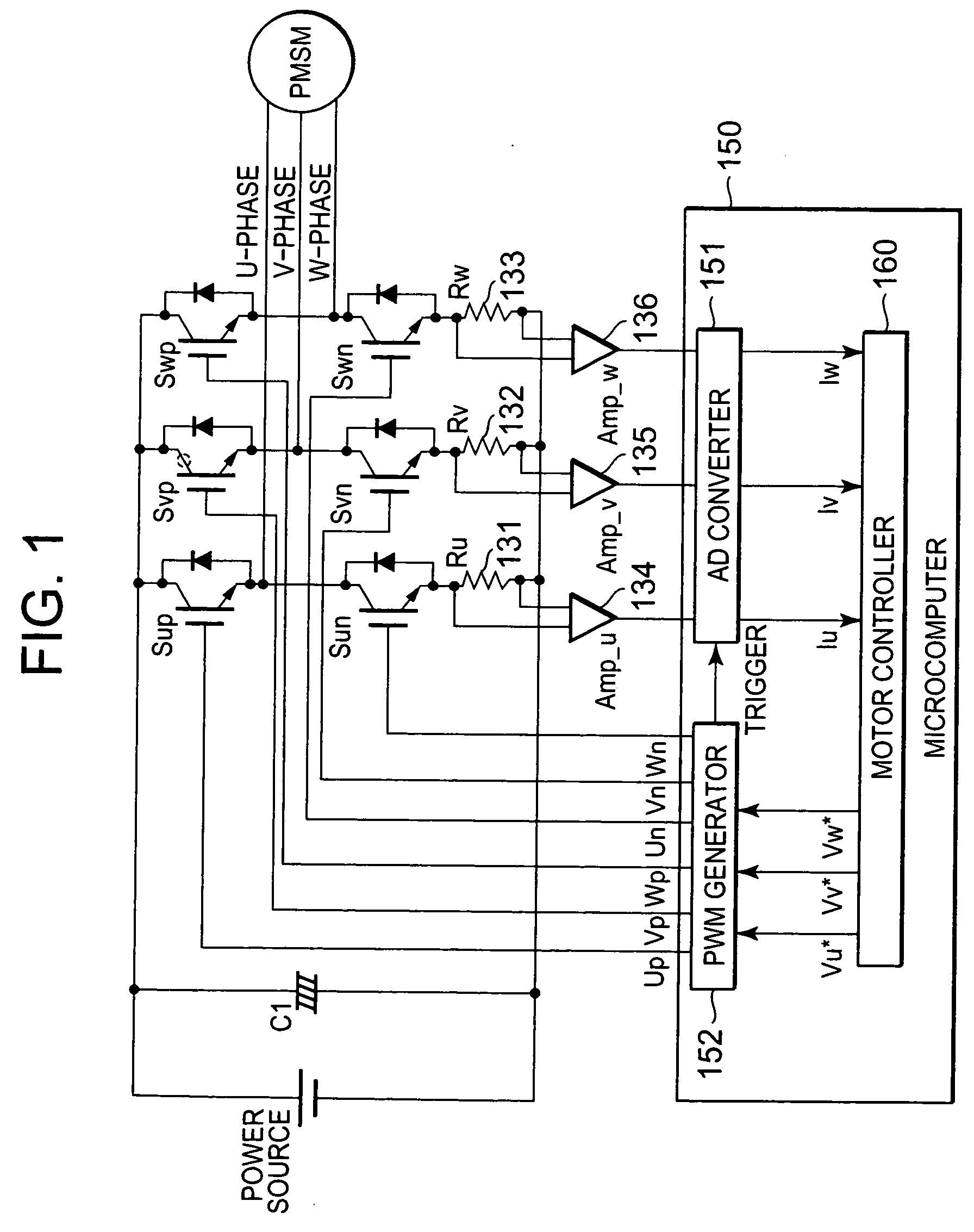Inverter apparatus and a semiconductor device used for the same
a technology of inverter apparatus and semiconductor device, which is applied in the direction of dynamo-electric converter control, dynamo-electric gear control, electric generator control, etc., can solve the problems of high cost, high speed of three-shunt detection method, and many problems of single-shunt detection method, so as to improve torque and speed ripple, and stabilize control
- Summary
- Abstract
- Description
- Claims
- Application Information
AI Technical Summary
Benefits of technology
Problems solved by technology
Method used
Image
Examples
first embodiment
[0044]FIG. 6 shows an inverter apparatus 10 according to a first embodiment of the present invention. Although this drawing seems similar to FIG. 1 described in the Related Art, a key difference therebetween is that this configuration includes a current detector correction unit 52 for performing correction of an imbalance among the current detectors explained in the principle diagrams. In the drawing, reference numeral 50 denotes a microcomputer, which is configured to control the switching elements, i.e. to perform motor control, and is usually formed of a semiconductor device. Moreover, although it is not shown in the illustration of the inverter apparatus in FIG. 6, this configuration also has other features such as a method of controlling the switching elements in order to perform correction of the deviation among the current detectors, for example. In this way, the first embodiment can also be grasped as the invention of a motor controlling method using the inverter apparatus 1...
second embodiment
[0080]The present invention has been described above in detail by using the three-shunt detection method as the example. Now, the two-shunt detection method will be briefly described with reference to FIG. 15. An inverter apparatus 80 shown in FIG. 15 includes current detectors 38 provided with only two amplifiers. That is, a major difference from FIG. 6 of the first embodiment is lack of the amplifier in the V-phase. Although a resistance element 42 is provided in the current detectors 38, this is another difference from the first embodiment because this is not the shunt resistance element as the current detector but is the resistance element intended to maintain the balance among the phases by simply equalizing a voltage drop relative to the U-phase and the W-phase as much as possible. Here, it is also possible to omit the resistance element 42. Other features are similar to the first embodiment, and further description on FIG. 15 will therefore be omitted. Moreover, in the two-sh...
third embodiment
[0087]The first embodiment and the second embodiment have described the example of using the PWM method in order to obtain the measurement circuit shown in FIG. 4B. However, it is not always necessary to use the PWM method. It is also possible to apply a method using a single pulse as described below.
[0088]FIG. 16 shows the method using the single pulse. In short, means for controlling the switching elements Sup 21 and Sun 22 is different from the first embodiment. Other features are the similar to the first embodiment. Accordingly, only the different features will be described below in detail for avoidance of overlapping explanation. Specifically, the method corresponding to FIG. 4A is shown in FIG. 11 while the method corresponding to FIG. 4B is shown in FIG. 13. Moreover, FIG. 12 showing the control of the switching elements Sup 21 and Sun 22 is replaced by FIG. 15.
[0089]This control method will now be described in detail. First, the switching element Sup 21 is turned on for a pr...
PUM
 Login to View More
Login to View More Abstract
Description
Claims
Application Information
 Login to View More
Login to View More - R&D
- Intellectual Property
- Life Sciences
- Materials
- Tech Scout
- Unparalleled Data Quality
- Higher Quality Content
- 60% Fewer Hallucinations
Browse by: Latest US Patents, China's latest patents, Technical Efficacy Thesaurus, Application Domain, Technology Topic, Popular Technical Reports.
© 2025 PatSnap. All rights reserved.Legal|Privacy policy|Modern Slavery Act Transparency Statement|Sitemap|About US| Contact US: help@patsnap.com



